人教版PEP六年级上册英语第六单元单元解读
Unit 6 How do you feel(单元解读)六年级英语上册(人教版PEP版)

六年级上册Unit 6 How do you feel?单元解读一、单元内容体现的课标理念本单元在英语核心素养的育人价值下进行,围绕单元主题“情绪及心理状态”以及“如何疏导情绪给与他人建议”展开教学。
本单元学习的主题主要是学习有关情绪的词汇以及如何舒缓情绪的词汇句型。
二、单元信息三、单元内容分析单元分为Main Scene、Part A、Part B和Part C四部分组成。
主要学习“讨论情绪以及如何疏导”这个话题。
在教学上,对本单元内容进行整合以及重组,主要对Part A 以及Part B的内容进行教授。
1.Main Scene,是主情景图,是本单元的知识总体预览,是本单元需要学生感知、理解并掌握的的核心语言点。
2.Part A主要包含Let's try, Let's talk, Let 's learn, Write and say四个环节。
在授课时,分为Let's learn & Write and say和Let's try& Let's talk两个课时。
①Let's learn & Write and say主要学习“angry, afraid, sad, worried, happy”等表示情绪的单词及关于表达情绪的句型“主语+be+表示情绪的形容词”。
①Let's try& Let's talk是一节听说课,Let's try让学生听听力圈出正确的答案,主要训练学生们的听力能力。
Let's talk 是一个对话,Sam和Sarah在讨论一个动画片,综合训练学生的口语表达以及听说读写的能力。
3.Part B部分主要包含Let's try, Let's talk, Let's learn, Play card games, Read and write, Let's check, Let's wrap it up七个环节。
人教版新课标PEP小学英语六年级上册Unit6 说课稿(第2课时)

人教版新课标PEP小学英语六年级上册Unit6 说课稿(第2课时)Unit 6 The Story of Rain本课是六年级上册第六单元的第二课时,即Unit6 The story of rain Part A Let’s talk.该单元是一个阅读单元,主要学习与自然现象和种植相关的一些单词,了解自然界水循环的过程和植物种植过程的表达,教学内容比较抽象,是英语学科与自然学科的渗透整合。
本节课主要是帮助学生听懂Let’s try 部分的录音,并正确写出标号,通过听说认读Let’s talk部分的对话,能用英语简单表达自然界水的循环过程。
这节课主要引导学生在认读对话的过程中了解水的循环过程,并尝试用英语简单表达水的循环过程,同时提醒学生关心世界性问题——地球水资源的缺乏,认识水的重要性,增强自然环境保护意识,注意保护水源、节约用水。
二、Learner Analysis六年级的学生已经具备了一定的英语基础,在以前的学习中也已经接触到了一些与自然界相关的一些单词,但在此之前学生还没有学过用英语表达某一种自然现象,关于水的循环过程学生在其他的学科中也有所了解,而且在本单元的主情景图中已经简单了解过,因此理解的难度不是太大,但对话中涉及到的两个生词become / shine 及相关的句子,是学生在表达时的一个难点,要创设具体语言情境引导学生感知理解,并通过趣味性的操练帮学生达到熟练表达。
三、Teaching aims根据教材的编排意图和学生的实际情况,结合新课标对高年级学生的具体要求,制定如下教学目标:1.能听懂Let’s try 部分的录音内容,完成标号练习。
2. 能听说认读本课对话,了解水的循环过程。
3. 能听说读写粗体句子,并熟练掌握主要句型:Where does the … come from? It comes from the ….4.能用英语简单描述自然界水的循环过程。
在外语教学中,学生只有在真实的语言情景或模拟情景中才能更好地理解所传递的信息和语言材料,才能激活学生的思维,从内心产生表达思想、展示自我的欲望。
pep人教版六年级上册英语各单元知识点
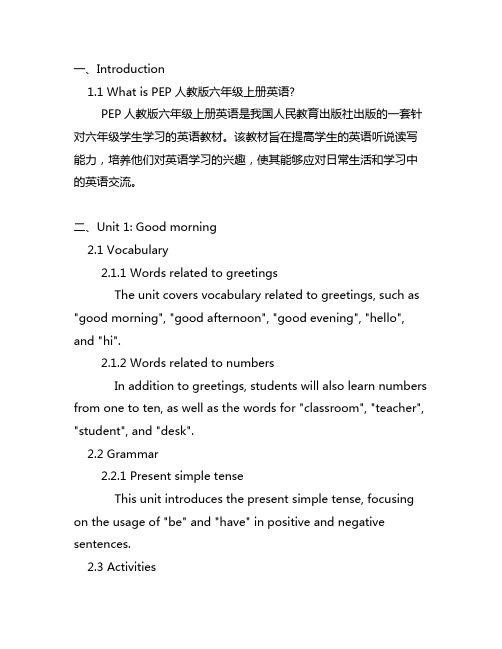
一、Introduction1.1 What is PEP人教版六年级上册英语?PEP人教版六年级上册英语是我国人民教育出版社出版的一套针对六年级学生学习的英语教材。
该教材旨在提高学生的英语听说读写能力,培养他们对英语学习的兴趣,使其能够应对日常生活和学习中的英语交流。
二、Unit 1: Good morning2.1 Vocabulary2.1.1 Words related to greetingsThe unit covers vocabulary related to greetings, such as "good morning", "good afternoon", "good evening", "hello", and "hi".2.1.2 Words related to numbersIn addition to greetings, students will also learn numbers from one to ten, as well as the words for "classroom", "teacher", "student", and "desk".2.2 Grammar2.2.1 Present simple tenseThis unit introduces the present simple tense, focusing on the usage of "be" and "have" in positive and negative sentences.2.3 Activities2.3.1 Role-playingTo practice the new vocabulary and grammar, students can engage in role-playing activities, where they take on the roles of greeting each other and asking basic questions in English.三、Unit 2: I can run3.1 Vocabulary3.1.1 Words related to sports and activitiesIn this unit, students will learn vocabulary related to sports and activities, including "run", "jump", "swim", "dance", "sing", "draw", and "read".3.1.2 Words related to expressing abilityAlong with sports vocabulary, students will also be introduced to words and phrases for expressing ability, such as "can" and "can't".3.2 Grammar3.2.1 Can and can'tThe grammar focus of this unit is on the usage of "can" and "can't" to express one's ability or inability to do something.四、Unit 3: At the zoo4.1 Vocabulary4.1.1 Words related to animalsThis unit covers vocabulary related to animals, such as "elephant", "panda", "tiger", "lion", "zebra", "giraffe", and "kangaroo".4.1.2 Words related to colorsStudents will also learn words for different colors, as many animals' physical characteristics are associated with specific colors.4.2 Grammar4.2.1 There is and there areThe grammar point of this unit is on the usage of "there is" and "there are" to talk about the existence of animals and objects at the zoo.4.3 Activities4.3.1 Describing animalsTo practice the new vocabulary and grammar, students can engage in activities where they describe different animals at the zoo using the words and phrases they have learned.五、Unit 4: Our classroom5.1 Vocabulary5.1.1 Words related to classroom objectsThis unit introduces vocabulary related to classroomobjects, such as "blackboard", "book", "pen", "pencil", "ruler", "desk", and "chair".5.1.2 Words related to prepositionsAlong with classroom objects, students will also learn prepositions such as "on", "in", "under", "behind", and "next to".5.2 Grammar5.2.1 Prepositions of placeThe grammar focus of this unit is on the usage of prepositions of place to describe the location of objects within the classroom.5.3 Activities5.3.1 Classroom scavenger huntTo reinforce the new vocabulary and grammar, students can participate in a classroom scavenger hunt, where they use prepositions to describe the location of different objects in the classroom.六、Unit 5: My school day6.1 Vocabulary6.1.1 Words related to school subjectsThis unit covers vocabulary related to school subjects, such as "Chinese", "math", "English", "music", "PE", "art", and puter".6.1.2 Words related to timeAlong with school subjects, students will also learn words and phrases related to time, such as "morning", "break", "lunch", "afternoon", and "evening".6.2 Grammar6.2.1 Present continuous tenseThe grammar focus of this unit is on the usage of the present continuous tense to talk about activities happening at the present moment.6.3 Activities6.3.1 Creating a daily scheduleTo practice the new vocabulary and grammar, students can create a daily schedule, using school subjects and time-related words to describe their typical school day.七、ConclusionThe PEP人教版六年级上册英语教材 covers a wide range of vocabulary, grammar, and activities that aim to provide students with a solid foundation in English language learning. By introducing topics such as greetings, sports, animals, classroom objects, and school subjects, the textbook offers students opportunities to engage in meaningful language use and develop essential language skills. With its systematicandprehensive approach to language learning, PEP人教版六年级上册英语 helps students cultivate their interest in English and facilitates their language acquisition process.。
六年级英语上册Unit 6 Part A 第1课时教案 人教版PEP
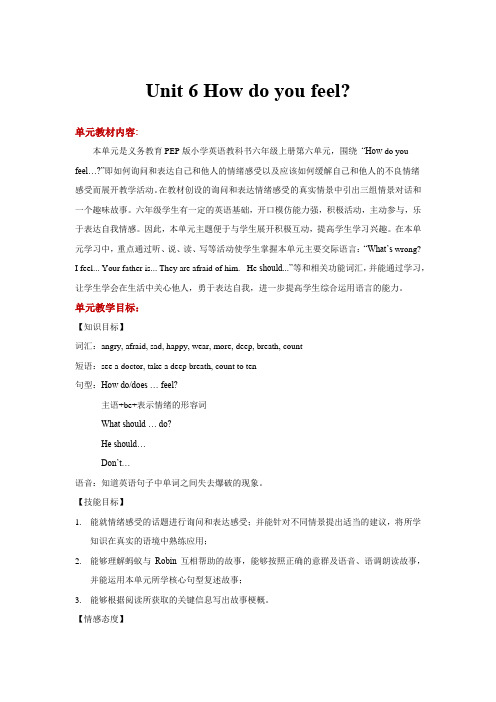
Unit 6 How do you feel?单元教材内容:本单元是义务教育PEP版小学英语教科书六年级上册第六单元,围绕“How do you feel…?”即如何询问和表达自己和他人的情绪感受以及应该如何缓解自己和他人的不良情绪感受而展开教学活动。
在教材创设的询问和表达情绪感受的真实情景中引出三组情景对话和一个趣味故事。
六年级学生有一定的英语基础,开口模仿能力强,积极活动,主动参与,乐于表达自我情感。
因此,本单元主题便于与学生展开积极互动,提高学生学习兴趣。
在本单元学习中,重点通过听、说、读、写等活动使学生掌握本单元主要交际语言:“What’s wrong?I feel... Your father is... They are afraid of him. He should...”等和相关功能词汇,并能通过学习,让学生学会在生活中关心他人,勇于表达自我,进一步提高学生综合运用语言的能力。
单元教学目标:【知识目标】词汇:angry, afraid, sad, happy, wear, more, deep, breath, count短语:see a doctor, take a deep breath, count to ten句型:How do/does … feel?主语+be+表示情绪的形容词What shou ld … do?He should…Don’t…语音:知道英语句子中单词之间失去爆破的现象。
【技能目标】1.能就情绪感受的话题进行询问和表达感受;并能针对不同情景提出适当的建议,将所学知识在真实的语境中熟练应用;2.能够理解蚂蚁与Robin互相帮助的故事,能够按照正确的意群及语音、语调朗读故事,并能运用本单元所学核心句型复述故事;3.能够根据阅读所获取的关键信息写出故事梗概。
【情感态度】1. 让学生知道不能自我为中心,并培养学生乐于助人,关爱他人的品质;2. 让学生明白不能以貌取人,要知恩图报。
(pep)人教版六年级英语上册unit6单元全套课件

Let’s learn & Write and say
Warm up Sing a song: If you’re happy, clap your hands
点击画面 播放视频
Lead in
How does she/he feel? feel [fiːl] 觉得,感到
Warm up
Review some words.
worried w-o-r-r-i-e-d
sad s-a-d
happy
angry
afraid
h-a-p-p-y a-n-g-r-y a-f-r-a-i-d
Play a game.
反义词: happy eg. He looks very sad.
Where is the cat?
The cat is in the tree. So Sarah is worried.
If you were Sarah, what will you say to the cat?
拓展:worry v. 担心 短语: be worried about 为……担心 eg. I'm worried about my friend.
Language points
主语 + be动词 + 表示情绪的形容词. 表达人物和动物的情绪和心理状态。
be动词随着主语而发生变化,用儿歌表示: 我用am,你用are,is 跟着他、她、它,单数is,复数 are,千万不要忘记了。
eg. I am happy. Sarah and Mike are sad.
feel 英译汉 感觉
二、单项选择。
PEP人教版六年级上册英语第六单元Unit 6 集体备课教学课件PPT
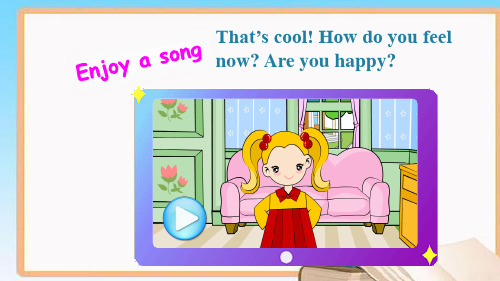
Practice
How does the cat feel?
It is happy.
How do they feel? They are sad.
How does the baby feel? He is very worried.
How does the dog feel? It is very afraid.
➢ What film will they watch? Can you guess? There is a cat on the DVD. Maybe it’s a film about a cat.
Let’s watch!
Watch and answer
Q1: What’s the cartoon about? Q2: What does the cat do?
That’s cool! How do you feel now? Are you happy?
Lead-in
How does Sarah feel?
How does Sarah feel?
She feels angry.
She feels sad.
How do you feel?
Unit 6 How do you feel?
angry.
happy.
Discuss in pairs.
How does he/she feel?
➢ One student come to the front of the classroom. Act out an emotion with actions and expressions.
How do you feel about Picture 1?
PEP人教版小学英语六年级上册Unit6单元教案

PEP人教版小学英语六年级上册Unit6单元教案In this lesson。
we will learn about ns and how to ask and describe them in English。
We will start with Let's Try。
where we will listen to a XXX。
Then。
we will move on to Let's Talk。
where we will watch a cartoon and learn new vocabulary words such as chase。
mice。
bad。
and hurt。
We will also practice using the "be + adjective" structure to ask about and XXX。
XXX By the end of this lesson。
we will be able to read。
write。
speak。
and understand XXX.What is his/her feeling。
教师引导学生描述图片中人物的情绪和动作,并帮助学生完成课本上的写作活动。
然后,教师让学生分组,互相表演场景,描述当事人的情绪。
教师提供帮助和反馈。
Step 3 Practice1.看图完成句子教师呈现图片,让学生根据图片完成句子,如:He is_________.He feels _________.学生可以在小组内讨论,然后向全班汇报。
2.口语练教师让学生分组,每组派两名代表到讲台前,一组表演一个场景,另一组描述当事人在这种场景中的感受。
教师提问:How does he/she feel?扩大操练范围。
Step 4 Summary教师总结本课教学内容和重点,让学生回答问题:What have we learned today。
人教PEP版小学英语六年级上册Unit1-6单元知识小结-全册完整版
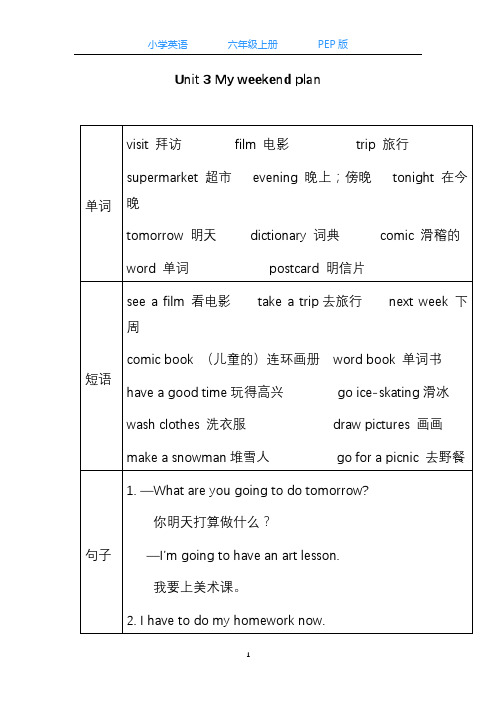
Unit 3 My weekend planUnit 4 I have a pen palUnit 5 What does he do?Unit 6 How do you feel?Unit 1 How can I get there?Unit 2 Ways to go to schoolPEP小学英语六年级上册重点单词和句型练习一、重点单词Unit 1:by ( ) foot( ) bike( ) bus( ) train( ) how( ) go to school() traffic()traffic light()traffic rule()stop()wait() get to()Unit 2library( ) post office( ) hospital( ) cinema( ) turn( ) bookstore( ) where( ) please( )next to( ) right ( ) left( ) straight( )then ( )Unit 3next week( ) this morning( ) this afternoon( )this evening ( ) comic book( ) post card( )newspaper( ) buy( )Unit 4hobby( ) ride a bike--riding a bike( ) dive--diving( )play the violin—playing the violin( ) make kites—making kites( ) collect stamps—collecting stamps( ) live –lives( ) teach--teaches( ) go--goes( ) watch--watches( ) read--reads( ) does doesn’t=does not Unit 5singer( ) writer( ) actor( ) actress( ) artist( ) TV reporter( ) engineer( ) accountant( ) policeman( ) salesperson( )cleaner( ) where() work()Unit 6rain( ) cloud ( ) sun( ) stream( ) come from( ) seed( ) soil( ) sprout ( ) plant( )should ( ) then( )Unit 1: ▁▁(经,乘) ▁▁(脚) ▁▁(自行车) ▁▁(公共汽车) ▁▁(火车)▁▁(怎样) ▁▁▁▁(上学)▁▁▁▁(交通)▁▁▁▁▁▁(交通灯)▁▁▁▁▁▁(交通规则)▁▁(停,停车站)▁▁(等待)▁▁▁▁(到达)Unit 2 ▁▁▁▁(图书馆) ▁▁▁▁(邮局) ▁▁▁▁(医院) ▁▁▁▁(电影院)▁▁(转弯) ▁▁▁▁(书店) ▁▁▁(在哪里,到哪里) ▁▁▁(请)▁▁▁(与…相邻) ▁▁▁ (右边) ▁▁(左边) ▁▁▁(成直线地) ▁▁▁(然后)Unit 3 ▁▁▁▁▁(下周) ▁▁▁▁▁(今天上午) ▁▁▁▁▁(今天下午) ▁▁▁▁ (今天晚上) ▁▁▁▁(漫画书) ▁▁▁▁(明信片) ▁▁▁▁ (报纸) ▁▁▁(购买)Unit 4▁▁▁(爱好) ▁▁▁▁▁--▁▁▁▁▁▁(骑自行车) ▁▁▁--▁▁▁(跳水) ▁▁▁▁▁▁—▁▁▁▁▁▁▁(拉小提琴) ▁▁▁▁▁—▁▁▁▁▁▁▁(制作风筝) ▁▁▁▁▁▁—▁▁▁▁▁▁(集邮) ▁▁▁–▁▁▁(居住)▁▁▁▁--▁▁▁▁(教) ▁▁--▁▁▁(去) ▁▁▁--▁▁▁(看)▁▁--▁▁▁(读,看) does doesn’t=▁▁▁▁Unit 5▁▁▁▁(歌唱家,歌手) ▁▁▁▁(作家) ▁▁▁▁(男演员) ▁▁▁▁(女演员) ▁▁▁▁(画家) ▁▁▁▁(电视台记者) ▁▁▁▁(工程师) ▁▁▁(会计) ▁▁▁▁(男警察) ▁▁▁▁▁▁(销售员) ▁▁▁(工作)▁▁▁▁(清洁工) ▁▁▁▁(在哪里,到哪里)Unit 6▁▁▁(雨) ▁▁▁ (云) ▁▁▁(太阳) ▁▁▁▁(河,溪) ▁▁▁▁(来自,从…来) ▁▁▁(种子) ▁▁▁(土壤) ▁▁▁ (苗,芽) ▁▁▁(植物,种植) ▁▁▁(应该) ▁▁▁▁(然后)二、单词分类1)交通方式:by bus, by train, by subway, by ship, by plane, by car, on foot2)文具书籍:dictionary, newspaper, comic book, post card3)职业:singer, writer, TV reporter, actor, actress, engineer, accountant, salesperson, policeman, policewoman,artist, cleaner4)V-ing形式:riding a bike, collecting stamps, diving, making kites, playing the violin5)第三人称单数形式:lives,teaches, watches, goes, does, doesn’t6)公共场所:library,post office, cinema, hospital, science museum, bookstore7)方位:east, west, south, north, turn left, turn right, go straight8)交通灯; red light, yellow light, green light9)自然:sun, cloud, rain, vapour, stream六年级上册四会句子1.你是怎样去上学的?▁▁▁▁▁▁▁▁2.通常我走路去上学。
人教版PEP 英语六年级上册 全册各单元知识点总结

人教版PEP 英语六年级上册全册各单元知识点总结Unit 1 How can I get there?一、地点词汇在问路时,掌握一些地点词汇是必要的,这些词汇包括library(图书馆)、post office(邮局)、XXX)、cinema(电影院)、bookstore(书店)、supermarket(超市)、school (学校)等等。
二、描述某地点所处位置的短语在描述某地点所处位置时,可以使用一些短语,如near (在…。
附近)、next to(与…。
相邻)、XXX(在…。
旁边)、in front of(在……前面)、behind(在…。
后面)、een(在…。
之间)等等。
三、问路当我们不知道某个地方在哪儿时,可以问路。
问路时,我们可以使用一些常用的句型,如“Where is the cinema。
please?”(请问电影院在哪儿?)、“Excuse me。
is there a cinema near here?”(请问这附近有电影院吗?)、“How can I get there?”(我怎样到那儿?)等等。
四、指引路当我们知道了某个地方的位置后,我们需要指引路。
指引路时,我们可以使用一些常用的短语,如“You can take the No.32 bus.”(你可乘坐312路公交车去那儿)、“Go straight and turn left at the bookstore.”(先直行然后在书店那儿左转弯)、“Turn right/ left at the …”(在…地方向右/左转)等等。
Unit 2: Ways to Go to SchoolDo you live far from school。
You may need to choose a XXX method to get there。
Here are some common n tools you can use: bike。
人教版PEP六年级英语上册第六单元课件 (1)

How do you feel now ?
We are happy.
Let’s try
• It’s cold outside. Sam and Sarah is talking. Listen and circle.
1. Where are they?
A. At home.
B. At school
Homework
• 熟记本课时对话内容,并进行听音模仿。
Unit 6 How do you feel ?
第四课时 Part B Let’s learn
&Play card games
angry
happy
afraid sad
worried
angry
sad afraid
happy
worried
A
Tutu and Xiaomei _a_r_e_ happy.
They __a_r_e__ happy.
She is
He is angry .
[ˈæŋgri]
The bird is
The dog is ill . Angala is sad .
生病的
[sæ d]
Cindy is worried .
• 4. A:I am so angry. What should I do? B:You should ___t_a_k_e_a_d_e_e_p__b_reaanthd __c_o_u_n_t_t_o_t_en.
What should I do?
see a doctor
sad
do more exercise
How do you feel? I’m sad
He should see a doctor.
最新人教版PEP英语六年级上册教案—复习教案Unit 6 单元教案 3

Unit 6 How do you feel?Period 1 Let’s learn Write and say P59教师寄语:(Never say die! 永不气馁。
)Learning aims(学习目标)1.能够听说读写单词:angry, afraid, sad, worried, happy.2. 能认读句型:人+be+表示感受的形容词。
Important &difficult points(重难点)掌握四会单词并能用它们描述自己或他人的情绪。
Learning steps(学习步骤)Step1预习温故. (用时5分钟)1. T: I’m a teacher. What do you do? Ss: I’m a student. T: What does he/ she do? Ss: He is a(n) fisherman/…T: Spell it. Ss: F-I-S-H-E-R-M-A-N/ …2. Do you know the facial expressions? (教师自画表情简笔画)Step2. 新课内容展示(用时15分钟)1. Learn: angry, afraid, sad, worried, happyT: I’m happy. How do you feel? Ss: I’m sad/ … (多读多操练)2. T: Look at this picture. Who is she? How does she feel?Ss: She is Sarah. She is angry. (边做表情边读单词angry)。
3.以同样的方法教学后面的单词afraid, sad, worried, happy.4. Listen to the tape and follow reading.5. 小组练习读单词、句子。
Step 3. 合作交流,师生共建(用时10分钟)Ss: He/ She/ The cat/ … is angry/ sad …(教师事先准备图片)Eg: The dog is afraid.Finish write and say.一个学生表演,其他学生说句子:He/ She is angry/ … 表演的学生说:Yes, I am angry/ …Step 4. 达标检测(用时8分钟)选出正确答案。
PEP人教版英语六年级上册-各单元重点词汇句型归纳整理
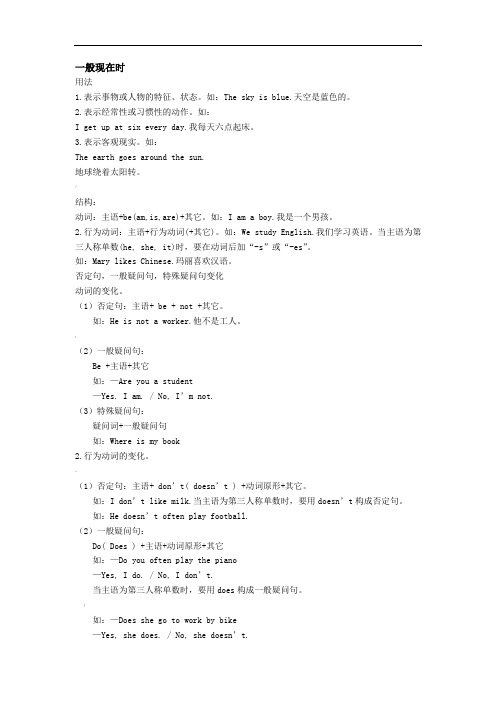
一般现在时用法1.表示事物或人物的特征、状态。
如:The sky is blue.天空是蓝色的。
2.表示经常性或习惯性的动作。
如:I get up at six every day.我每天六点起床。
3.表示客观现实。
如:The earth goes around the sun.地球绕着太阳转。
/结构:动词:主语+be(am,is,are)+其它。
如:I am a boy.我是一个男孩。
2.行为动词:主语+行为动词(+其它)。
如:We study English.我们学习英语。
当主语为第三人称单数(he, she, it)时,要在动词后加“-s”或“-es”。
如:Mary likes Chinese.玛丽喜欢汉语。
否定句,一般疑问句,特殊疑问句变化动词的变化。
(1)否定句:主语+ be + not +其它。
如:He is not a worker.他不是工人。
:(2)一般疑问句:Be +主语+其它如:—Are you a student—Yes. I am. / No, I’m not.(3)特殊疑问句:疑问词+一般疑问句如:Where is my book2.行为动词的变化。
(1)否定句:主语+ don’t( doesn’t ) +动词原形+其它。
如:I don’t like milk.当主语为第三人称单数时,要用doesn’t构成否定句。
如:He doesn’t often play football.(2)一般疑问句:Do( Does ) +主语+动词原形+其它如:—Do you often play the piano—Yes, I do. / No, I don’t.当主语为第三人称单数时,要用does构成一般疑问句。
(如:—Does she go to work by bike—Yes, she does. / No, she doesn’t.(3)特殊疑问句:疑问词+一般疑问句如:How does your mother go to work一般过去时一、一般过去时的概念》一般过去时表示过去某个时间发生的动作或状态。
人教版六年级上册英语1到6单元带读

第一单元:Hello!1. 介绍第一单元的主题:打招呼和自我介绍。
2. 介绍重点词汇和句子:hello, hi, my name is, nice to meet you等。
3. 解释每个单词的意思和用法。
4. 给出一些例句。
5. 提醒学生练习在日常生活中多多打招呼和自我介绍。
第二单元:My Classroom1. 介绍第二单元的主题:教室及其中的物品。
2. 列举物品的英文名称,如desk, ch本人r, book等。
3. 解释每个单词的意思和用法。
4. 指导学生在课堂上做一些简单的问答练习。
5. 强调课堂纪律的重要性。
第三单元:My Family1. 介绍第三单元的主题:家庭成员及其关系的表达。
2. 教授家庭成员的英文名称,如father, mother, brother, sister等。
3. 提供一些常用的句型,如This is my father, She is my sister等。
4. 鼓励学生多加练习,在家庭成员前使用英文来进行交流。
第四单元:My Weekend1. 介绍第四单元的主题:周末活动的英文表达。
2. 教授一些常见的周末活动的单词,如play, swim, read等。
3. 提供例句并进行练习。
4. 鼓励学生在周末和家人或朋友用英文进行交流,共享自己的周末活动。
第五单元:My Schoolbag1. 介绍第五单元的主题:学习用品的英文表达。
2. 列举各种学习用品的名称,如pen, pencil, ruler, eraser等。
3. 指导学生练习用英文描述自己的书包以及书包里的物品。
4. 强调学习用品的使用及保存的重要性。
第六单元:Happy Birthday1. 介绍第六单元的主题:诞辰的英文表达。
2. 教授与诞辰相关的词汇,如cake, present, party等。
3. 提供一些与诞辰相关的句子并进行练习。
4. 鼓励学生学会用英文祝福他人的诞辰,并参与到诞辰聚会中。
人教版PEP英语六年级上册Unit 6 单元教学设计(含教学反思)

教学目标1.能够掌握句子“They are afraid of him.The cat is angry with them.”并能在实际情景中熟练运用。
2.能听、说、认、读单词“chase,mice,bad,hurt”。
3.能够独立完成“Let s try”部分的练习。
4.能以正确的语音语调表演“Let s talk”部分。
5.教育学生要有良好的心理状态,善于表达自己的感受。
重点掌握四会句子“They are afraid of him.The cat is angry with them.”。
难点能在实际情景中熟练运用所学句型。
教具准备人物头饰、教学光盘、课件教学过程Step 1:Warm-up播放本单元的歌曲,“If you are happy,clap your hands”可向学生解释歌词的大概意思,可重点解释“happy,angry”的含义,并让学生边听边做出与歌词相应的动作。
Step 2:Presentation1.老师介绍背景:It s cold outside,Sam is talking with Sarah.提出问题让学生思考:Where are they?What will they do?核对答案,并再次播放听力,让学生能找出问题的关键信息,理解对话大意。
2.由“Let’s try”部分了解到“Sam and Sarah will watch films.”让我们一起看看“What films will they see?”3.老师展示“Let s talk”部分挂图,展示Sarah拿出的图片,并提问,让学生讨论:What’s the film about?What does the cat do?并引入Let’s talk话题。
T:The film is about a cat.The cat is a police officer.4.出示更多关于“the police officer—cat”的图片,并展示猫捉老鼠的图片。
人教版PEP六年级英语上册第六单元课件

Summary
• How does she /he feel ?
angry
• She/He is
afraid sad
worried
happy
Homework
• 回家听Let’s learn部分的录音两遍,抄写重 点单词。
What's wrong?怎么啦?
• 用于询问对方有什么问题或有什么不顺心 的事,意为“怎么了,出什么事情了”
• --What's wrong?--I have a headache. • --What's wrong?--He lost my bike.
• You father is ill. • 你们的父亲生病了。 • sick 也有“生病的,有病的”之意。
Unit 6 How do you feel?
Part B let’s talk
go to the doctor =see a doctor
应该
看病
“主语 +should +动词原形”句型
表示“建议,要求等”.
做更多的练习
穿暖和的衣服
---------------------
---------并----且----数----到----十--------------------------------
课件
PPT
小学教学课件
PPT
Unit 6 How do you feel? 第一课时
Part A Let’s try&Let’s talk
A: How do you feel? B:I am…
I feel…
人教PEP六年级英语上册课件Unit 6
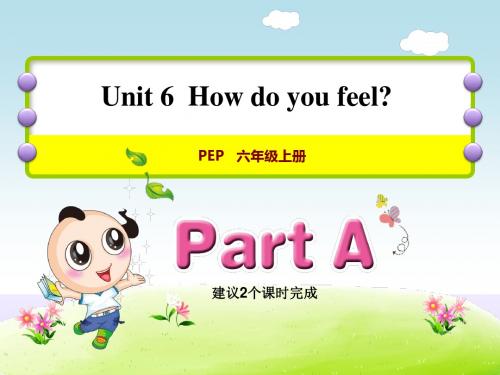
讲解来自《点拨》
知识点 2 He should see a doctor this morning... 他应该今天上午去看病…… 考向 用情态动词should提建议的陈述句 句型是: 主语+should+动词原形+其他。它对应的 问句是:What should+主语+do?
讲解来自《点拨》
易错点 提示 should后接动词原形,没有人称和数的变化。 他应该吃更多的水果。 (×)He should eats more fruit. ( √ )He should eat more fruit.
习题来自《点拨》
一、单项选择。 1. The children are ________ one another on the playground. C A.chase B.chaseing C.chasing
点拨: 句意为“孩子们在操场上相互追逐。”分析句
子可知是现在进行时,所以应用chase的现在 分词形式:chasing。
Sam: Oh, no! Mum: Don’t be sad. We can go next time. Sam: How does Dad feel now? Mum: Not well. Let’s go to the hospital.
How does Sam feel? What should he do?
My watch doesn’t work. (3)询问机器或东西的故障情况。 我的表不走了。
讲解来自《点拨》
拓展
如果想问某人或某物具体怎么了,句型是:What’s
wrong with+人/物? 注意人称代词用宾格形式。
例句:—What’s wrong with her? 她怎么了?
—She is ill.她生病了。
新版PEP小学英语六年级上册1-6单元知识点总结

一、问路1. Where is the cinema, please next to the hospital. in front of the school.beh ind the park n ear the zoo. on the right/left of the bookstore.在书店的左/ 右边. east of the bank. 在银行的 东边. i far from here.离这儿 很远.请问这附近有电影院吗 有./没有。
我该怎样到达医院呢 You can take the bus. Go straight for three minu tes. Turn right/ left at the Walk east/ west/ south/ n orth for 三 Is it far from here离这儿远吗Yes, it is. / No, it isn 是的很远t 不是很远。
Unit 2 Ways to go to schoolsubway 地(^)(交通工具前加by ,表示乘坐但步行要用on foot )(二)、重点句型 ①询问交通方式用疑问代词howplaces: (地点)六年级PEP 上册知识总结 Un itl How can I get therelibrary 图书馆 post office 邮局 hospital 医院 ci nema 电影院 bookstore 书店 scie nee mu 科学博物馆 pet hospital 宠物医院 school 学校 supermarket 超市 shoe store 鞋店 north 北) turn left 左转 turn right 右转 东)east cross in 十 souths^wes 西()字路口go straigh 直 行请问电影院在哪儿在医院的旁边。
在学校的前面. 在公园的后面 在动物园的附近.It ' s J 2. Excuse me, is there a cin ema n earhereY es, there is. /No,there isnt.3. How can I get to the hospitalTake the …..…二、指引路 1. 2. 3. 4. 你可乘坐312路公交车去那儿. 向前直走在分钟. …在…地方向右/左转. 朝东•/ nSn 南e 北匕/走…分钟. 知识点归纳J 、 词汇 四会交通工具 traffic tools<bike (自行车)bu 公共汽车)tra 火车) pla ne 飞叽) shi 轮船)taxi 出租车b 乘坐)slow down 慢下来foo (脚)stop 停下来 how 怎样) go to schoo 止 学) sled 雪橇ferry 轮渡—— How do you go/come to school你怎样去/来上学----- I go/come to school on foot . 我走路去/ 来上学。
- 1、下载文档前请自行甄别文档内容的完整性,平台不提供额外的编辑、内容补充、找答案等附加服务。
- 2、"仅部分预览"的文档,不可在线预览部分如存在完整性等问题,可反馈申请退款(可完整预览的文档不适用该条件!)。
- 3、如文档侵犯您的权益,请联系客服反馈,我们会尽快为您处理(人工客服工作时间:9:00-18:30)。
3
4
Look at the ant. It is _______. so small and not strong. small. They are strong. All of the ants are not ____. _____.
Union makes strength.
团结就是力量!
再次阅读短文补全对话并复述。
3
2
1
4
afraid
worried
pull Robin out of the mud
is happy
P44 Read and order
5
1
4 2 7 6
P44
afraid
1. G: John is watching a movie.
B: How does he feel? G: He is afraid.
通过本单元的学习,了解西方国家的人如何在不同的情境中表 达情绪感受,并在情境中体会中外交际习俗的差异。
学习策略目标 能够积极运用所学英语进行表达和交流,注意倾听,积极思考。
/paike/V8PV2GDG7/VAMAPF91I.html
angry
2018/10/18
happy
angry
3. Someone says bad words to Zhang[Peng. H is very angry.
2. Mike has some new storybooks. He is so happy.
P44
1. Why is Amy still in bed? Because she feels sick. 2. What’s the matter with Amy? She has a headache and she feels cold. 3. What should Amy do? She should see a doctor.
1. Number the paragraphs
标出段落序号
2. Divide the Paragraphs into 2 parts
把短文分成两层
1
2
3 4 5
6 7
1 2
Part1
sunny It is _______. an ant Robin meets ______. Robin the ant ____ helps ______.
happy
afraid
hot
hungry
sad
cold
afraid
2018/10/18
worried
2018/10/18
see a doctor
2018/10/18
do more exercise
wear warm clothes
2018/10/18
take a deep breath
What’s the story about ?
It’s about Robin and the Ant.
快速阅读短文给图片标序号。
3
2 stuck duck 陷
1
afraid
4
It is a sunny morning. Robin is going to sit on the grass when he hears, ”Wait!” It is a little ant. He is afraid. “Please don’t sit on me. One day I can help you.” “Don’t worry, little ant. I won’t sit on won’t=will not you,” says Robin. I am not going to sit on you. 1. How does the ant feel ? A. He is afraid. B. He is worried. 2. Why is the ant afraid ? the ant 1 Because Robin is going to sit on him .
PEP六上 Unit 6 How do you feel ?
单元教学目标: 知识目标 1、能够掌握本单元出现的单词和词组,如:ill\ worried afraid sad angry happy take a deep breath count to ten 等,并能熟练朗读与运用。 2、通过对话学习能够熟悉掌握询问和表达情绪感受的主要句 型:what’s wrong? I feel… your father is ___ they are afraid of 等并能针对不同 情景提出建议,将所学知识在真实的语境中熟练运用。 3、学会唱一首英文歌曲”If you’re happy, clap your hands”,了解一句谚语 No pleasure without pain.
2018/10/18
take a deep breath and count to ten
2018/10/18
happy afraid worried warm
……
angry sad ill hungry
wear warm clothes see a doctor do more exercise take a deep breath count to ten ……
1. 能熟练朗读文本,有能力学生可以背诵。
2. 完成家庭作业本。
3.欣赏故事《The lion and the mouse》
检测题:
检测题:
1. How ____ you feel? A. do B. does
2. How ____ he feel? A. do B. does 3.How ____ they feel? A. do B. does
能力目标 通过本单元的学习和各种各样的活动,让学生在生活中能够运 用本单元词汇和主要句型进行询问和回答关于情绪感受的话题, 并能根据不同的情绪感受状况劝导他人。
PEP六上 Unit 6 How do you feel ?
情感态度目标 通过本单元的学习培养学生乐于助人、关爱他人的品质,提高 学生学英语的兴趣。 文化意识目标
Part1 1 2 3
Read after it
点此音频超链接
Does the ant help Robin one day?
Yes, she does.
Please _____________. don’t sit on me I can help you One day _____________. Don’t worry little ant. __________, I won’t sit on you ______________.
( 1 ) It is a
morning.
( 2 ) Robin is going to sit on the grass. An ant stops him.
-How does the ant feel? -_________________. She is afraid//worried
Wait!
3. Is Robin going to sit on the ant ?
A. Yes, he is. B. No, he isn’t.
The next day, it is raining. Robin is in the park. He is stuck in the mud. He is 泥 陷入 worried. study stu duck uck but u
3. Is Robin going to sit on the ant ?
A. Yes, he is. B. No, he isn’t.
It is a sunny morning. Robin is going to sit on the grass when he hears, ”Wait!” It is a little ant. He is afraid. “Please don’t sit on me. One day I can help you.” “Don’t worry, little ant. I won’t sit on won’t=will not you,” says Robin. I am not going to sit on you. 1. How does the ant feel ? A. He is afraid. B. He is worried. 2. Why is the ant afraid ? 1 Because Robin is going to sit on him .
The next t day, it is raining.
3
4 5 6
Part2
raining It is _______.
Robin meets the ant again.
7
The ants help ______. Robin ______
Read and order.
读短文,给句子标号
(4 ) Robin is in the park. He is stuck in the mud. ( 1 ) It is a sunny morning. ( 2 ) Robin is going to sit on the grass. An ant stops him. ( 3 ) The next day, it is raining. ( 5 ) Robin is worried. ( 7 ) Robin and the ants are happy at last. ( 6 ) The ants are strong. They pull Robin out of the mud.
3
2
1
4
Listen and repeat
